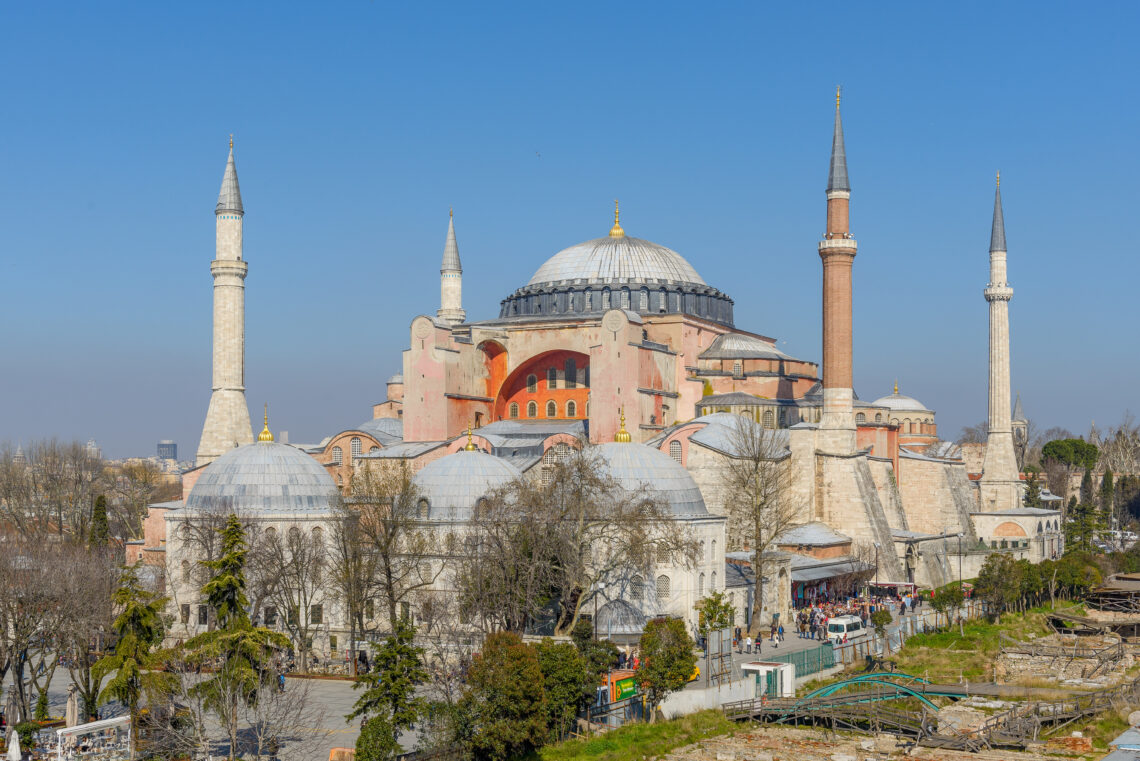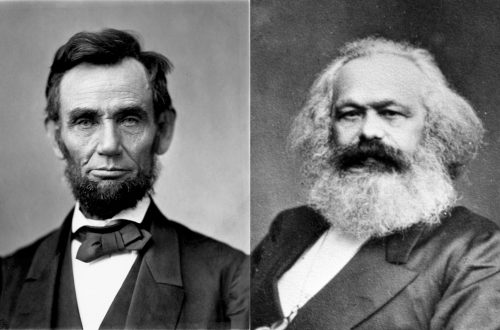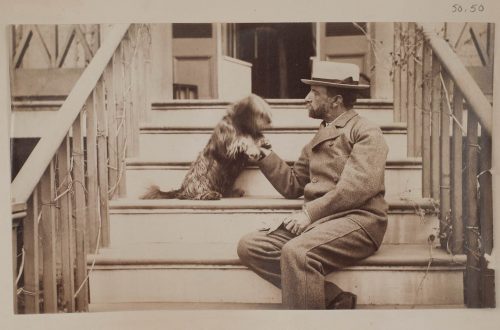by Dennis Staffelbach
“O, Solomon, I have vanquished thee!” So exclaimed Emperor Justinian upon the completion of his great church of Holy Wisdom, the Hagia Sophia. Built in less than six months, it was the largest church in Christendom for almost a millennium. “[It] presents a most glorious spectacle, extraordinary to those who behold it and altogether incredible to those who are told of it. In height it rises to the very heavens and overtops the neighboring houses like a ship anchored among them, appearing above the city which it adorns and forms a part of…It is distinguished by indescribable beauty, excelling both in size and the harmonies of its measures.” Thus reads Procopius’ sixth-century description, and I can find no better today.
Even though Emperor Justinian certainly intended to create a Christian church that would match the grandeur of King Solomon’s Temple, he was undoubtedly more motivated by the opportunity to surpass his archrival’s church, St. Polyeuktos. A noblewoman with direct lineage to both Valentinian III and Theodosius the Great, Anicia Juliana was the sole patron of the Church of St. Polyeuktos (which was purposefully modeled on Solomon’s Temple). In fact Juliana’s husband and son were both failed contenders to the imperial throne. Justinian had won out. But her church was a different story. St. Polyeuktos was the largest and most sumptuous church in all the empire. So, of course, Justinian’s Hagia Sophia must surpass it.
I visited the Hagia Sophia museum in 2015. Like Procopius, I too was stunned by its “indescribable beauty” and opulence, as well as its enduring, even stubborn, sacredness. But what about Juliana’s stupendous edifice, the rival church St. Polyeuktos? For that, I took a short 30-minute walk to the interior of the old Constantinople. Eventually I saw a massive ruin with a small marker. As I looked down through a chain link fence into a vast, grave-like trench, the great aqueduct of Valens was just over my left shoulder. The vestiges of an ancient foundation were evident, albeit overrun with weeds and shrubbery; the stale stench of urine was overpowering. At one time these unexcavated ruins were protected, but today the government doesn’t discourage Syrian refugees and other homeless souls from using them as a makeshift shelter and toilet. So lies the ancient infrastructure of Juliana’s great church of St. Polyeuktos. Walking around the ruins, I remember thinking that I could pocket any artifact lying around and no one would notice, no one would care.
How is it that these two massive, domed churches could experience such diverse histories? The history of St. Polyeuktos’ monument is brief. It was an active church until at least the tenth century, then abandoned, eventually looted (including by the thirteenth-century Crusaders), and over time…forgotten. Its ruins were accidentally discovered in the 1960s with the construction of an overpass, while Justinian’s monument to Holy Wisdom, the Church of Hagia Sophia, continues to make history.
In almost every society, from the time of Amenhotep, Hammurabi, and the first kings of Israel to the present, politics and religion have been tightly interwoven. Only when I spent some time in the Hagia Sophia immersed in her history did I ever reflect on how a place of worship, the actual physical structure, could play so prominently in power politics. In ancient times, to demonstrate the complete subjugation of a foreign power, the modus operandi was simply to destroy or kidnap the enemy’s deity and raze its temple. Even the church of St. Polyeuktos, the product of an imperial bloodline fallen from grace, was allowed to deteriorate. The Hagia Sophia, however, became the greatest church in Christendom for over a millennium, and later one of the most controversial and important mosques in the Islamic world.
But like no other physical structure in the world, the Hagia Sophia reflects the conflicted political and religious history of one of the world’s most historically significant cities, first as Byzantium, then Constantinople, and now, Istanbul. And just as Istanbul is encompassed by the Golden Horn and the Bosporus Strait, the Hagia Sophia, which lies within its massive double walls, is surrounded and haunted by its history as it transmogrified from a Byzantine church and patriarchate to a Roman Catholic cathedral, an imperial Ottoman mosque, a twentieth-century secular museum, and now a mosque again. Its very existence may be a consequence of how it developed into a strategically political edifice as well as a house of worship.
In the fourth century A.D., Byzantium’s strategic location along the Bosporus Strait became so evident that Constantine the Great moved his imperial capital from Rome to the ancient Greek colony. (Indeed, he ordered the construction of the first “Hagia Sophia” on the site of an ancient pagan temple.) He insisted that Byzantium would be his “Nova Roma.” It seems that he was more popular than the name, so his “New Rome” became “Constantinople,” the city of Constantine. Regardless of its nomenclature, Constantinople went on to serve as the capital of the Eastern Roman Empire for over 1,100 years, while Rome withered to a virtual ghost town. When the Western Roman Emperor, Romulus Augustulus, was finally deposed in 476 A.D., he and his capital were so inconsequential that their German conquerors didn’t even bother to execute the emperor. Like Constantinople, the Hagia Sophia itself became symbolically significant, but it was also seen as a political prize. Muhammad is said to have prophesied that the Hagia Sophia would someday become a grand mosque, which it did 800 years later. Before that, it was at the center of the ninth-century Iconoclastic Controversy, then conquered by the Latin Crusaders and transformed into a Roman Catholic cathedral. In 1453, when Sultan Mehmet II the Conqueror finally seized Constantinople, he almost immediately ordered that the slowly dilapidating church be preserved and converted into a “great and grand” imperial mosque.
Moderns too have understood the symbolic historical significance of this “monument.” In 1935, the founder of Turkey, Kemal Ataturk, in order to further his secularist political ideology, converted the Hagia Sophia into a museum of art and architecture. After five centuries as the capital’s center of Islamic worship, it was now a secular museum. It was also a signal to the West that he and his newly-established Republic of Turkey would not be following the way of the “Oriental Ottoman Despot” but would pursue a more universalist, democratic, and western-leaning foreign policy. Apparently he thought that converting a place of worship into a museum was more western-leaning. The then-Education Minister, Abidin Ozmen, commented later on the conversion of the Hagia Sophia into a museum: “It was said…chiefly by Ataturk, that instead of keeping it as something [that] belongs to one religion and class, that turning Hagia Sophia into a museum that is open to visitors from all nations and religions would be suitable.” The Hagia Sophia went on to become one of the most visited museums in the world, and Turkey as a whole indeed leaned west. It went on to enter World War II on the side of the Allies, join NATO, and fight shoulder-to-shoulder with American troops in the Korean War. (Turkey currently provides the second largest army of all NATO countries, second only to the United States.)
Finally, some 95 years later, Turkey is steering a different political course, and the Hagia Sophia is at the center of this movement. For 20 years, President Erdogan repeatedly refused demands that he reestablish the Hagia Sophia as a mosque, calling them “provocative.” In 2021, he abruptly reversed his position. In an appeal to a form of religious nationalism favored by his increasingly conservative Islamic base, Erdogan returned the Hagia Sophia’s status to that of a mosque. So, once again, the Hagia Sophia is at the nexus of a spiritual and political controversy. This may just be a way for Erdogan to divert attention from his failed economic policies. But as author and historian Foti Benlisoy warns: “It would be a mistake to think that [returning landmark museums to their original status as mosques] is only about petty gains in domestic politics…these acts of re-Islamisation or de-Westernisation are likely reflections of a ‘neo-Ottoman’ orientation toward the building of ‘an alternative national identity.’”
Perhaps because Christian emperors, as well as their Ottoman counterparts, received their crowns within its hallowed walls, and modern politicians manage it like a valuable chess piece, the Hagia Sophia will remain one of history’s great buildings. But it begs the question: once a church becomes politicized or commercialized, can it ever reestablish itself as a sacred place? Considering the story of the Hagia Sophia, could she have ever truly rivaled Solomon’s Temple?

Dennis Staffelbach lives in South Bend, Indiana with his wife, five sons and adopted twin daughters. From teacher to attorney and to teacher again, Dennis has been having interesting conversations and sharing stories with young people in the classroom for the last 30 years. He also enjoys reading, hunting, and exploring foreign cultures. Dennis spent four weeks in Istanbul, Turkey in 2015 at a NEH summer seminar entitled Istanbul: Crossroads of History.
Header Image: Arild Vågen, CC BY-SA 3.0 , via Wikimedia Commons





